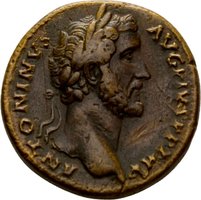
"Honos or Honor was the Roman god personifying honor. He was closely associated with Virtus, the goddess of manliness, or bravery, and the two are frequently depicted together. Honos is typically shown wearing a chaplet of bay leaves, while Virtus is identified by her helmet.
In 234 BC, Quintus Fabius Maximus Verrucosus dedicated a temple to Honos just outside the Porta Capena, one of Rome´s principal gates, following his victory over the Ligures. Twelve years later, after Marcus Claudius Marcellus defeated and slew the Gallic king, Viridomarus, at the Battle of Clastidium, to win the spolia opima, he vowed a temple to Honos and Virtus. He renewed this vow after capturing Syracuse in 212 BC, during the Second Punic War, and while consul in 208 he attempted to fulfill it by rededicating the existing temple in the name of both gods. The College of Pontiffs refused to allow this, so Marcellus restored the temple of Honos, and built a second, adjoining shrine to Virtus, making a double temple. Marcellus was slain in an ambush near Venusia later that year, so the temple was dedicated by his son in 205. It was richly adorned with treasures that Marcellus had brought from Syracuse, although many of these disappeared over the next two centuries.[10][11] The temple was restored by Vespasian, and was still standing in the fourth century AD.[12]" - (en.wikipedia.org 31.01.2020)
